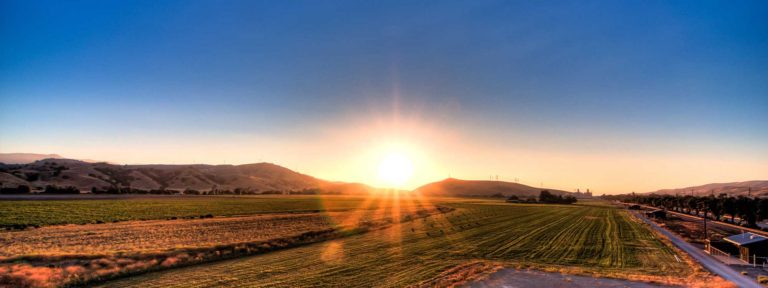Coyote Valley (Photo from Greenbelt Alliance)
Under the watchful eyes of dozens of community activists who hours earlier had rallied outside on the plaza, San Jose’s City Council held a study session Jan. 22 to discuss plans for Coyote Valley.
The valley is a 7,400-acre swath of farms and undeveloped land extending south from San Jose to Morgan Hill, between the Santa Cruz Mountains on the west and the Diablo Range to the east.
By an overwhelming margin 71% voters in November endorsed Measure T, which authorized the city to float $650 million in bonds for infrastructure improvements throughout San Jose, including up to $50 million to buy land in Coyote Valley for conservation purposes.
Among the expected benefits are natural flood mitigation, enhanced groundwater protection and wildlife habitat and open space for recreational purposes.
The city must now decide how to spend the bond money. Besides Coyote Valley, the city is looking at what to prioritize with the other $600 million of bond money, intended to be spent fixing roads and bridges and upgrading fire stations and emergency operations.
But the Jan. 22 study session was all about how to proceed in Coyote Valley. And although the voting public spoke clearly in its 71% support of Measure T, developers and Coyote Valley property owners are holding out hopes of making more money by building there. The city could opt to spend less than the $50 million voters authorized, or look for options that would still allow some Coyote Valley development. But, Greenbelt Alliance program director Brian Schmidt told Ethnic Media Services, doing so would “not be following the spirit of the measure.”
Over the course of four and a half hours, the City Council heard presentations organized into three categories: “Land Use Planning,” “Environmental Perspective” and “Development Perspective.” Then, for 45 minutes, the public was allowed a chance to address the council, in one-minute increments per speaker.
Opening the land use planning portion of the discussions, Chris Burton, deputy director of the city’s Office of Economic Development, reminded the council that Coyote Valley development had long factored into the city’s planning as an “employment lands growth area.” As such, it has been expected to deliver tens of thousands of jobs, primarily from an industrialized northern sector of the valley. San Jose land with that designation is in relatively short supply and job opportunities are limited for those without higher education degrees.
The environmental panel emphasized the hope of creating a wildlife corridor so animals can range freely between the mountain ranges. By restoring the valley’s Laguna Seca wetlands and taking full advantage of unpaved ground’s ability to absorb rainfall, the city will be protecting and replenishing the aquifer, they argued, safeguarding the source of a third of the city’s drinking water. Doing so would also help prevent catastrophic flooding such as the city experienced in December 2017 and is continuing to remediate, at a cost surpassing $100 million. They also emphasized the value of protecting a natural habitat for people’s recreational use and reminded the council that aesthetic values also can provide economic benefits.
Burton also led the development presentation, with representatives of real estate developer Scannell Corp, real estate investment firm Jones, Lang LaSalle, and Kate Sofis, of SFMake and Manufacture: San Jose.
Collectively, they argued that Coyote Valley represents the city’s best opportunity to attract businesses that can’t afford downtown rents and would otherwise find Newark, Fremont, Tracy or Livermore more attractive options.
In the question-and-answer period that followed, Mayor Sam Laccardo asked them about the added cost developers face due to the state’s VMT vehicle miles traveled assessment. The VMT factor is a product of the state legislature’s SB 743 from 2013, which San Jose chose to implement in 2018. It will apply statewide by July 2020, part of the state’s goal of reducing greenhouse gases, it imposes a fee on new projects based on their anticipated traffic impacts.
A 200,000- to 500,000-square-foot facility, employing 1,000-1,200 workers, would incur about $17 million in transit fees, the Scannell Corporation representative calculated.
“No matter how much they want to be near San Jose, they’re going to move to Tracy or Livermore,” he said.
“The state (California) may have just decided this for us,” Laccorda replied.
District 10 council rep Johnny Khamis asked how much flooding might be prevented by preserving the open space, and had some pointed questions about the effect of surrendering possible job creation by declining to industrialize Coyote Valley.
An unofficial appraisal of the privately held Coyote Valley lands is about $130 million. The Peninsula Open Space Trust has pledged to pony up what the city cannot and already begun the process.
Other possible sources of funding include FEMA (the Federal Emergency Management Agency) and the Army Corps of Engineers, which support flood mitigation efforts.
Dozens of people filled out public comment cards for the opportunity to voice their opinions at the conclusion of the session. Some called for “a balanced approach.” Others bemoaned a “short-term pursuit of tax revenue,” saying “the jobs are not going to be coming full force” because changes in technology, for example, are likely to alter the economic landscape.
Others emphasized the special qualities of the land in its natural state. “This is unique, irreplaceable and also a flood plain,” one said. “Coyote Valley is doing its actual, natural job. Just protect the land and stick with the voters.”
The next City Council meeting, on Feb. 12, will feature more comprehensive discussions about Measure T. Three council members were absent for the Coyote Valley study session: District 4’s Lan Diep, District 5’s Magdalena Carrasco and District 8’s Sylvia Arenas.
The worst possible outcome, Schmidt told Ethnic Media Services, would be if proposed warehouse development were approved. Such spaces, which provide only a few jobs, would avoid the disincentive posed by the VMT assessment but have an outsized environmental effect by paving over the natural sponge that open land provides.




